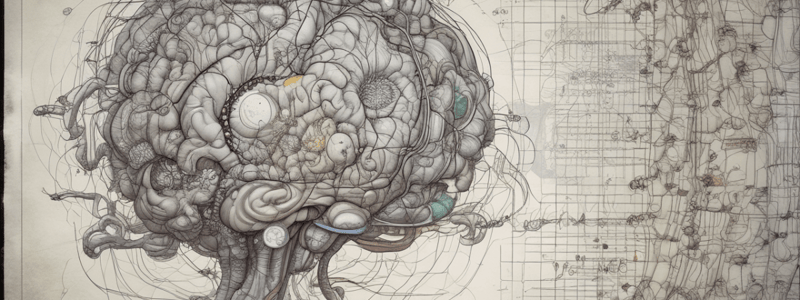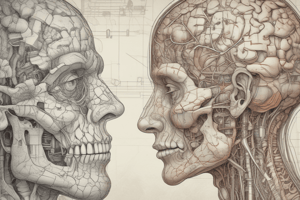Podcast
Questions and Answers
What is the primary function of ion channels in the generation of action potentials?
What is the primary function of ion channels in the generation of action potentials?
- To regulate the refractory period
- To initiate muscle contractions
- To control the flow of ions that drive the membrane voltage changes (correct)
- To transmit information between neurons
Which type of ion channel is responsible for the rapid depolarization and repolarization phases of the action potential?
Which type of ion channel is responsible for the rapid depolarization and repolarization phases of the action potential?
- Voltage-gated channels (correct)
- Mechanically-gated channels
- Ion-pump channels
- Ligand-gated channels
What occurs during the depolarization phase of the action potential?
What occurs during the depolarization phase of the action potential?
- The membrane potential becomes more negative
- The membrane potential changes randomly
- The membrane potential becomes more positive (correct)
- The membrane potential remains unchanged
What is the purpose of the refractory period in the generation of action potentials?
What is the purpose of the refractory period in the generation of action potentials?
What occurs during the repolarization phase of the action potential?
What occurs during the repolarization phase of the action potential?
What is the role of synaptic transmission in the generation of action potentials?
What is the role of synaptic transmission in the generation of action potentials?
What type of ion channels allow for the continuous passage of ions across the membrane?
What type of ion channels allow for the continuous passage of ions across the membrane?
What is the initial phase of an action potential?
What is the initial phase of an action potential?
During which phase of the refractory period can the neuron respond to stimuli?
During which phase of the refractory period can the neuron respond to stimuli?
What is the main driver of the repolarization phase of the action potential?
What is the main driver of the repolarization phase of the action potential?
What is the result of the binding of neurotransmitters to receptors on the postsynaptic neuron?
What is the result of the binding of neurotransmitters to receptors on the postsynaptic neuron?
What is the purpose of the refractory period in the action potential?
What is the purpose of the refractory period in the action potential?
What is the result of the continued efflux of potassium ions during the final phase of the action potential?
What is the result of the continued efflux of potassium ions during the final phase of the action potential?
What is the role of leak channels in the generation of action potentials?
What is the role of leak channels in the generation of action potentials?
What is the result of the influx of sodium ions during the rising phase of the action potential?
What is the result of the influx of sodium ions during the rising phase of the action potential?
What is the purpose of the action potential in the nervous system?
What is the purpose of the action potential in the nervous system?
Study Notes
Action Potentials: The Fundamentals of Neuronal Communication
Action potentials are electrical signals that travel along the membranes of neurons, enabling communication between different regions of the nervous system. These potentials are crucial for the proper functioning of the nervous system, as they allow for the transmission of information between neurons and the initiation of muscle contractions. In this article, we will discuss the key components and processes involved in the generation of action potentials, including ion channels, depolarization, the refractory period, repolarization, and synaptic transmission.
Ion Channels
Ion channels are specialized membrane proteins that allow the passage of ions, such as sodium (Na+) and potassium (K+), across the cell membrane. These channels are essential for the generation of action potentials, as they control the flow of ions that drive the membrane voltage changes during the potentials. Ion channels are selective for specific ions and can be classified into three main types:
-
Voltage-gated channels: These channels respond to changes in the membrane potential and are responsible for the rapid depolarization and repolarization phases of the action potential.
-
Ligand-gated channels: These channels are activated by the binding of specific molecules, such as neurotransmitters, to receptors on the membrane surface. They play a key role in the generation of graded potentials and the initiation of action potentials in response to neurotransmitter release.
-
Leak channels: These channels allow for the continuous passage of ions across the membrane, maintaining a resting potential and contributing to the generation of action potentials.
Depolarization
Depolarization is the initial phase of an action potential, where the membrane potential becomes less negative, moving towards the threshold for the activation of voltage-gated sodium channels. When these channels open in response to a threshold-level depolarization, sodium ions rapidly rush into the cell, further depolarizing the membrane. This rapid influx of sodium ions creates a rapid increase in membrane potential, known as the rising phase of the action potential.
Refractory Period
After an action potential has been generated, the neuron enters a refractory period, during which it is unable to produce another action potential in response to a stimulus. The refractory period is divided into two phases:
-
Absolute refractory period: During this phase, the neuron is completely refractory to stimuli and cannot generate an action potential.
-
Relative refractory period: In this phase, the neuron can respond to stimuli, but the stimulus must be stronger than the threshold for generating an action potential. This is due to the persistence of a hyperpolarizing afterpotential, which makes it more difficult for the membrane potential to reach the threshold for another action potential.
Repolarization and Synaptic Transmission
After the peak of the action potential, the membrane potential rapidly becomes more negative again, returning to its resting level. This phase, known as repolarization, is mainly driven by the influx of potassium ions and the efflux of sodium ions. The final phase of the action potential is a brief period of hyperpolarization, during which the membrane potential is more negative than the resting potential. This hyperpolarization is caused by the continued efflux of potassium ions and the slow closure of voltage-gated potassium channels.
Once the action potential reaches the axon terminus, neurotransmitters are released into the synaptic cleft, where they bind to receptors on the postsynaptic neuron. This binding causes the opening or closing of ligand-gated ion channels, leading to changes in the membrane potential of the postsynaptic neuron. If the membrane potential reaches the threshold for an action potential in the postsynaptic neuron, a new action potential will be generated and propagated along the postsynaptic neuron, continuing the process of neuronal communication.
In conclusion, action potentials are complex electrical signals that are generated by the coordinated activity of ion channels, depolarization, repolarization, and synaptic transmission. These potentials are essential for the proper functioning of the nervous system, allowing for the rapid and efficient transmission of information between neurons and the initiation of muscle contractions.
Studying That Suits You
Use AI to generate personalized quizzes and flashcards to suit your learning preferences.
Description
Learn about the key components and processes involved in the generation of action potentials, including ion channels, depolarization, refractory period, repolarization, and synaptic transmission. Understand the crucial role of action potentials in the proper functioning of the nervous system.




